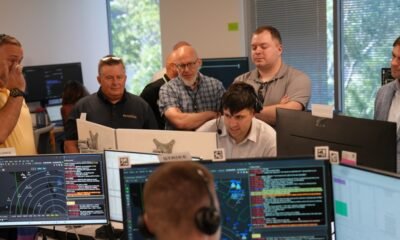AI Research
The Transformative Potential of AI in Intelligence Analysis

In an era of extraordinary geopolitical volatility, the U.S. Intelligence Community (IC) is confronting increasingly complex challenges that demand innovative technological solutions. Unprecedented amounts of data collection, the threats posed by great power competition, and the rapid transformation of regional security landscapes have heightened the need for advanced intelligence capabilities that go beyond traditional analytic methodologies.
At the same time, structural changes within the federal workforce under the Trump administration, including voluntary buyout programs and early retirements, have reduced the pool of experienced intelligence analysts, operators, and leaders. This evolving workforce dynamic increases the need for innovative solutions to maintain operational continuity and effectiveness, and to ensure the IC can fulfill its role of providing timely and relevant intelligence about the plans, intentions, and capabilities of our adversaries.
In this context, AI is a transformative force, poised to revolutionize how intelligence is collected, analyzed, and operationalized. Unlike previous technological advancements, AI represents a paradigm shift, reimagining intelligence operations from the ground up. Machine learning algorithms process and synthesize massive, multidimensional datasets with a speed and precision that human analysis alone cannot achieve. Further, by automating routine analytical tasks and augmenting human expertise in more complex decision-making, AI can help fill critical gaps, offering more scalable and efficient intelligence operations.
Before examining these partnerships further, it’s essential to clarify what is meant by “AI” in this context. Large Language Models (LLMs) like those powering current chatbots can already perform many of the tasks discussed here and represent the most immediate opportunities for IC integration, including processing natural language, synthesizing information from multiple sources, and generating analytic summaries. Other capabilities—such as fully autonomous predictive analytics systems that can anticipate geopolitical shifts with high accuracy, or AI that can seamlessly correlate intelligence across all collection disciplines—remain largely aspirational. Their potential deployment in high-stakes operational intelligence environments would require significant additional development, testing, and validation.
Public-Private Collaboration
The integration of AI technologies presents a unique, mutually beneficial opportunity for collaboration between private technology firms and the IC. Government agencies possess extensive classified information and deep substantive and operational expertise, while AI companies offer cutting-edge algorithms, flexible development frameworks, and advanced computational capabilities.
This symbiotic relationship can help address critical intelligence challenges in several ways. First, the public sector can leverage machine learning to anticipate geopolitical shifts and emerging security risks with increased accuracy and granularity, improving the timeliness of both strategic and tactical intelligence. This could include AI systems that analyze multiple economic indicators to predict economic instability that often precedes political upheaval. Or it could use machine learning models to process millions of social media posts, news articles, and online discussions in multiple languages to detect rising social tensions, protest movements or anti-government sentiment before these indicators manifest in actual unrest.
Second, developing advanced natural language processing and computer vision technologies can help synthesize intelligence from and increase the utility of diverse, unstructured data sources. This could include using AI to simultaneously process optical satellite imagery, synthetic aperture radar, and signals intelligence to create comprehensive pictures of military installations, troop movements, or infrastructure development that no single source could provide.
Finally, adaptive AI systems can detect and respond to sophisticated digital threats in real time. This could include using AI to detect cyber intrusions by analyzing network traffic patterns, detecting the spread of state-sponsored propaganda in real time, or even identifying potential insider threats that might otherwise be undetectable.
As noted in recent statements by Secretary of Defense Pete Hegseth and Director of National Intelligence Tulsi Gabbard, there is a growing recognition that US national security demands technological agility over traditional bureaucratic structures. Emerging procurement models and public-private partnerships signal a shift toward greater openness to innovation, particularly for unclassified open-source information, creating new opportunities for AI companies to engage.
While the national security imperative drives these partnerships, AI firms also gain significant strategic advantages through their collaboration with the IC. Perhaps most valuable is access to some of the world’s most comprehensive and sophisticated data repositories, providing AI companies with unparalleled training opportunities for machine learning models. This access enables the development of more robust, real-world tested algorithms that can be applied across multiple commercial sectors, giving firms a substantial competitive advantage in civilian markets.
Government contracts also provide sustained funding for cutting-edge research that might be too risky or long-term for traditional commercial investment. This includes exploration of emerging technologies that can later be commercialized across industries.
In addition, successfully delivering AI solutions to the IC serves as powerful validation of a company’s technical capabilities, and an endorsement from the US Government—even if the precise details remain classified—can significantly enhance credibility with other high-stakes clients in finance, healthcare, and critical infrastructure sectors. The rigorous security and performance standards required for intelligence work demonstrate a level of technical excellence that translates directly to commercial advantage.
Working on intelligence challenges can also attract top-tier technical talent, many of whom are looking for opportunities in the private sector that allow them to continue contributing to the national security mission. These personnel provide teams with experience in handling complex, mission-critical systems—skills that translate directly to enhanced competitiveness in the broader technology marketplace.
Navigating Challenges: Transparency, Validation, and Workforce Transformation
The convergence of AI and the US national security ecosystem presents significant challenges that must be addressed for successful implementation. Central to these concerns is the need for transparency in AI-government relationships. The IC must be able to explain how its conclusions are reached, particularly when those conclusions inform critical national security decisions. This transparency requirement extends beyond traditional sourcing to include understanding the decision-making processes of AI systems themselves.
AI results, like all other intelligence sources, require critical evaluation and validation. This means intelligence professionals must understand the proprietary algorithms they’re relying upon—their training data, inherent biases, confidence levels, and failure modes. The IC cannot afford to treat AI outputs as black boxes, regardless of their apparent sophistication or accuracy.
This need for algorithmic transparency creates tension with the proprietary nature of many commercial AI systems. Companies naturally want to protect their intellectual property, while intelligence agencies need to understand the tools they’re using to assess national security threats. Resolving this tension will require new frameworks for sharing algorithmic insights without compromising competitive advantages.
Ethical considerations, data privacy, and security concerns also require rigorous governance frameworks. Transparent protocols, robust validation mechanisms, and a shared commitment to responsible AI development is essential for successful collaboration.
AI’s integration also raises important questions about workforce transformation within the intelligence sector. While machine learning and advanced algorithms can increasingly perform data analysis, pattern recognition, and predictive modeling, this does not—and certainly should not—signal wholesale human replacement. The most promising models envision a collaborative approach where AI augments the work of analysts and operators, freeing up personnel to focus on higher-order cognitive tasks, such as providing contextual analysis, making strategic judgments, and performing ethical reasoning that remain uniquely human.
This transition will require investments in reskilling and upskilling programs to ensure that intelligence professionals can effectively leverage AI tools while maintaining critical human elements like intuition, cultural understanding, and complex decision-making.
The rapid evolution of AI intersects with pressing national security demands in ways that have the potential to improve our operational readiness, intelligence effectiveness, and strategic decisionmaking. The explosion of publicly available information has created an immediate need for advanced AI-enabled collection and analysis capabilities. While such tools can be developed and deployed in unclassified environments, their strategic value lies in demonstrating operational relevance and interoperability with existing intelligence workflows.
Cybersecurity presents an especially acute challenge, as adversaries adopt increasingly adaptive and automated attack methods. AI-enabled threat detection, behavioral analysis, and automated response systems are emerging as central components of resilient cyber defense architectures. Similarly, the global acceleration of multilingual, real-time communication–particularly in volatile regions–drives demand for AI systems capable of translation, sentiment analysis, and information triage at scale, particularly when dealing with social media.
The advancement of AI capabilities suggests the possibility of implementing predictive analytics platforms in the future that can synthesize economic, social, and political indicators to assess the potential for regional instability, migration, or competition over critical resources. Such capabilities could enable decisionmakers to anticipate and mitigate emerging threats rather than react to them. Similarly, systems that can automatically correlate intelligence from satellites, human sources, signals intelligence, and open sources to provide comprehensive all-source threat assessments would enhance the sophistication of IC analysis and represent a major advancement in agency interoperability, data governance, and ultimately, national security.
FEATURED IMAGE: The United States Capital with a backdrop of a digital canvas (via Getty Images)
AI Research
How artificial intelligence is transforming hospitals

Story highlights
AI is changing healthcare. From faster X-ray reports to early warnings for sepsis, new tools are helping doctors diagnose quicker and more accurately. What the future holds for ethical and safe use of AI in hospitals is worth watching. Know more below.
AI Research
AI is becoming the new travel agent for younger generations, survey finds

Is travel planning the next space AI is taking over?
A new survey shows that younger Americans are relying on AI and ChatGPT more and more to construct their vacation itineraries.
The survey of 2,000 Americans (split evenly by generation) by Talker Research found that only 29% of millennials have never used AI for this reason, with just 33% of Gen Z saying the same.
This is a stark contrast to older generations that still rely on old-school, traditional methods to sort their travel plans. Seven in ten baby boomers also say they have never used AI for their travel plans.
IN CASE YOU MISSED IT | Travel cutbacks: Americans planning shorter, more frequent trips this summer
So exactly how are people utilizing AI in this way? The interesting results emerged in Talker Research’s new travel trend report.
The top application for AI in travel planning was found to be asking it to compare flight prices for wherever they’re headed, with 29% of all those polled saying they’ve done this.
A similar amount says AI comes in even before that: Twenty-nine percent of respondents have even asked it where they should go for their trip.
Another one in five even let AI complete a detailed plan for their whole trip, complete with sights to see, local things to do and museums to tick off.
While word of mouth and recommendations from loved ones have always been the most common way to learn about fun places to travel, the survey revealed that there’s a new contender.
YouTube (34%) was crowned as the top resource people use for travel inspo, officially topping recommendations from family (30%) and friends (28%).
The generations were split on this, as unsurprisingly, younger generations were a lot more reliant on social media than older generations.
FROM THE ARCHIVES | Affordable travel destinations that can save you thousands of dollars
While YouTube was the most popular when accounting for every survey-taker, Gen Z was overwhelmingly using TikTok for travel inspiration (52%).
In comparison, just 27% of millennials and only 2% of boomers said they use TikTok for this purpose.
While AI is still fairly new, it’s easy to see this trend growing as the technology becomes more sophisticated.
Survey methodology:
This random double-opt-in survey of 2,000 Americans (500 Gen Z, 500 millennials, 500 Gen X, 500 baby boomers) was conducted between May 5 and May 8, 2025 by market research company Talker Research, whose team members are members of the Market Research Society (MRS) and the European Society for Opinion and Marketing Research (ESOMAR).
AI Research
If I Could Only Buy 1 Artificial Intelligence (AI) Chip Stock Over The Next 10 Years, This Would Be It (Hint: It’s Not Nvidia)

While Nvidia continues to capture headlines, a critical enabler of the artificial intelligence (AI) infrastructure boom may be better positioned for long-term gains.
When investors debate the future of the artificial intelligence (AI) trade, the conversation generally finds its way back to the usual suspects: Nvidia, Advanced Micro Devices, and cloud hyperscalers like Microsoft, Amazon, and Alphabet.
Each of these companies is racing to design GPUs or develop custom accelerators in-house. But behind this hardware, there’s a company that benefits no matter which chip brand comes out ahead: Taiwan Semiconductor Manufacturing (TSM -3.05%).
Let’s unpack why Taiwan Semi is my top AI chip stock over the next 10 years, and assess whether now is an opportune time to scoop up some shares.
Agnostic to the winner, leveraged to the trend
As the world’s leading semiconductor foundry, TSMC manufactures chips for nearly every major AI developer — from Nvidia and AMD to Amazon’s custom silicon initiatives, dubbed Trainium and Inferentia.
Unlike many of its peers in the chip space that rely on new product cycles to spur demand, Taiwan Semi’s business model is fundamentally agnostic. Whether demand is allocated toward GPUs, accelerators, or specialized cloud silicon, all roads lead back to TSMC’s fabrication capabilities.
With nearly 70% market share in the global foundry space, Taiwan Semi’s dominance is hard to ignore. Such a commanding lead over the competition provides the company with unmatched structural demand visibility — a trend that appears to be accelerating as AI infrastructure spend remains on the rise.
Image source: Getty Images.
Scaling with more sophisticated AI applications
At the moment, AI development is still concentrated on training and refining large language models (LLMs) and embedding them into downstream software applications.
The next wave of AI will expand into far more diverse and demanding use cases — autonomous systems, robotics, and quantum computing remain in their infancy. At scale, these workloads will place greater demands on silicon than today’s chips can support.
Meeting these demands doesn’t simply require additional investments in chips. Rather, it requires chips engineered for new levels of efficiency, performance, and power management. This is where TSMC’s competitive advantages begin to compound.
With each successive generation of process technology, the company has a unique opportunity to widen the performance gap between itself and rivals like Samsung or Intel.
Since Taiwan Semi already has such a large footprint in the foundry landscape, next-generation design complexities give the company a chance to further lock in deeper, stickier customer relationships.
TSMC’s valuation and the case for expansion
Taiwan Semi may trade at a forward price-to-earnings (P/E) ratio of 24, but dismissing the stock as “expensive” overlooks the company’s extraordinary positioning in the AI realm. To me, the company’s valuation reflects a robust growth outlook, improving earnings prospects, and a declining risk premium.
TSM PE Ratio (Forward) data by YCharts
Unlike many of its semiconductor peers, which are vulnerable to cyclicality headwinds, TSMC has become an indispensable utility for many of the world’s largest AI developers, evolving into one of the backbones of the ongoing infrastructure boom.
The scale of investment behind current AI infrastructure is jaw-dropping. Hyperscalers are investing staggering sums to expand and modernize data centers, and at the heart of each new buildout is an unrelenting demand for more chips. Moreover, each of these companies is exploring more advanced use cases that will, at some point, require next-generation processing capabilities.
These dynamics position Taiwan Semi at the crossroad of immediate growth and enduring long-term expansion, as AI infrastructure swiftly evolves from a constant driver of growth today into a multidecade secular theme.
TSMC’s manufacturing dominance ensures that its services will continue to witness robust demand for years to come. For this reason, I think Taiwan Semi is positioned to experience further valuation expansion over the next decade as the infrastructure chapter of the AI story continues to unfold.
While there are many great opportunities in the chip space, TSMC stands alone. I see it as perhaps the most unique, durable semiconductor stock to own amid a volatile technology landscape over the next several years.
Adam Spatacco has positions in Alphabet, Amazon, Microsoft, and Nvidia. The Motley Fool has positions in and recommends Advanced Micro Devices, Alphabet, Amazon, Intel, Microsoft, Nvidia, and Taiwan Semiconductor Manufacturing. The Motley Fool recommends the following options: long January 2026 $395 calls on Microsoft, short August 2025 $24 calls on Intel, short January 2026 $405 calls on Microsoft, and short November 2025 $21 puts on Intel. The Motley Fool has a disclosure policy.
-
Tools & Platforms3 weeks ago
Building Trust in Military AI Starts with Opening the Black Box – War on the Rocks
-

 Business2 days ago
Business2 days agoThe Guardian view on Trump and the Fed: independence is no substitute for accountability | Editorial
-

 Ethics & Policy1 month ago
Ethics & Policy1 month agoSDAIA Supports Saudi Arabia’s Leadership in Shaping Global AI Ethics, Policy, and Research – وكالة الأنباء السعودية
-

 Events & Conferences3 months ago
Events & Conferences3 months agoJourney to 1000 models: Scaling Instagram’s recommendation system
-

 Jobs & Careers2 months ago
Jobs & Careers2 months agoMumbai-based Perplexity Alternative Has 60k+ Users Without Funding
-

 Funding & Business2 months ago
Funding & Business2 months agoKayak and Expedia race to build AI travel agents that turn social posts into itineraries
-

 Education2 months ago
Education2 months agoVEX Robotics launches AI-powered classroom robotics system
-

 Podcasts & Talks2 months ago
Podcasts & Talks2 months agoHappy 4th of July! 🎆 Made with Veo 3 in Gemini
-

 Podcasts & Talks2 months ago
Podcasts & Talks2 months agoOpenAI 🤝 @teamganassi
-

 Mergers & Acquisitions2 months ago
Mergers & Acquisitions2 months agoDonald Trump suggests US government review subsidies to Elon Musk’s companies






















